INFINITI QX60-HYBRID 2017 Owners Manual
Manufacturer: INFINITI, Model Year: 2017, Model line: QX60-HYBRID, Model: INFINITI QX60-HYBRID 2017Pages: 655, PDF Size: 7.01 MB
Page 381 of 655
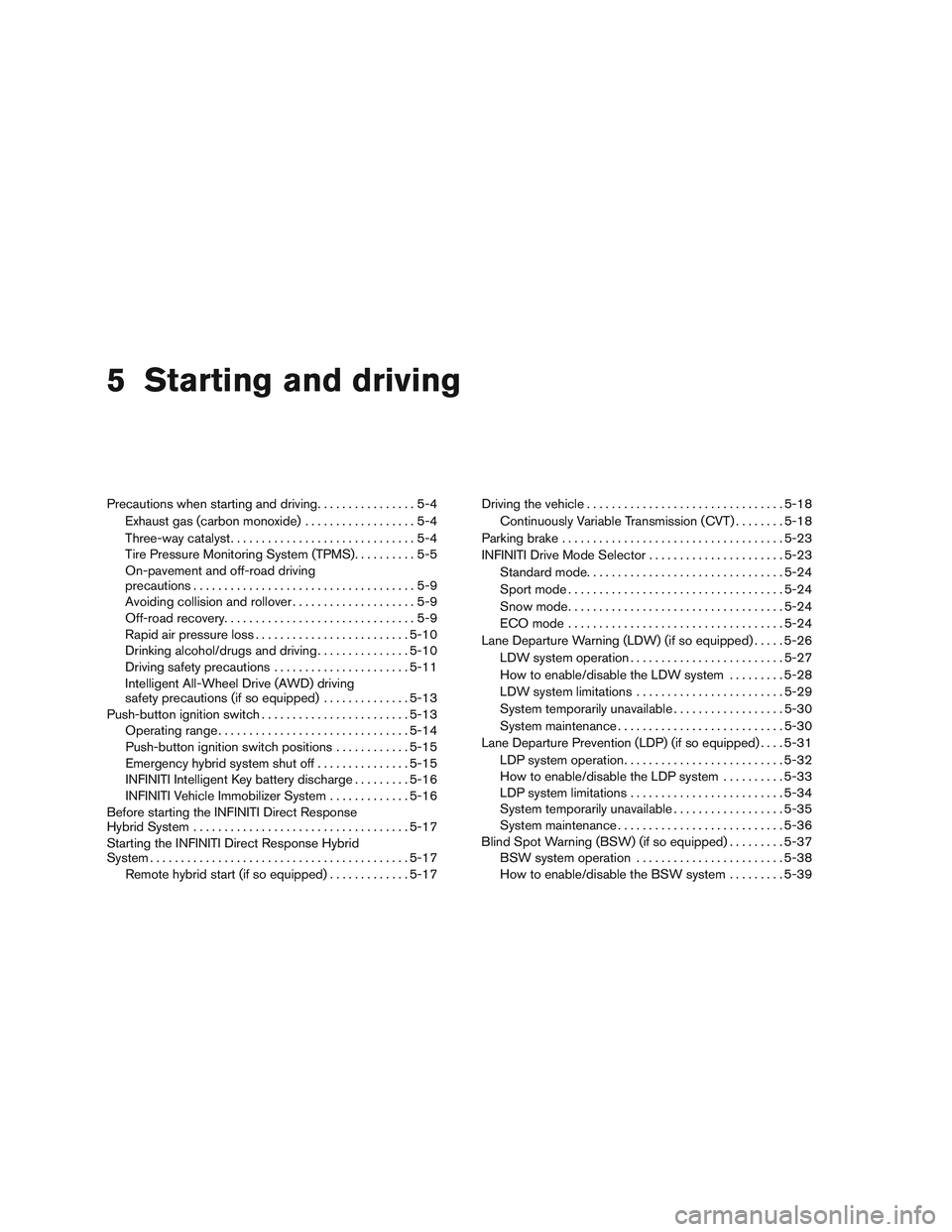
5 Starting and driving
Precautions when starting and driving................5-4
Exhaust gas (carbon monoxide) ..................5-4
Three-way catalyst ..............................5-4
Tire Pressure Monitoring System (TPMS) ..........5-5
On-pavement and off-road driving
precautions ....................................5-9
Avoiding collision and rollover . . ..................5-9
Off-road recovery ...............................5-9
Rapid air pressure loss ......................... 5-10
Drinking alcohol/drugs and driving ...............5-10
Driving safety precautions ......................5-11
Intelligent All-Wheel Drive (AWD) driving
safety precautions (if so equipped) ..............5-13
Push-button ignition switch ........................5-13
Operating range ............................... 5-14
Push-button ignition switch positions . . . .........5-15
Emergency hybrid system shut off ...............5-15
INFINITI Intelligent Key battery discharge .........5-16
INFINITI Vehicle Immobilizer System .............5-16
Before starting the INFINITI Direct Response
Hybrid System ................................... 5-17
Starting the INFINITI Direct Response Hybrid
System .......................................... 5-17
Remote hybrid start (if so equipped) .............5-17Driving the vehicle
................................ 5-18
Continuously Variable Transmission (CVT) ........5-18
Parking brake .................................... 5-23
INFINITI Drive Mode Selector ......................5-23
Standard mode ................................ 5-24
Sport mode ................................... 5-24
Snow mode ................................... 5-24
ECO mode ................................... 5-24
Lane Departure Warning (LDW) (if so equipped) .....5-26
LDW system operation ......................... 5-27
How to enable/disable the LDW system .........5-28
LDW system limitations ........................ 5-29
System temporarily unavailable ..................5-30
System maintenance ........................... 5-30
Lane Departure Prevention (LDP) (if so equipped) ....5-31
LDP
system operation .......................... 5-32
How to enable/disable the LDP system ..........5-33
LDP system limitations ......................... 5-34
System temporarily unavailable ..................5-35
System maintenance ........................... 5-36
Blind Spot Warning (BSW) (if so equipped) .........5-37
BSW system operation ........................ 5-38
How to enable/disable the BSW system .........5-39
Page 382 of 655
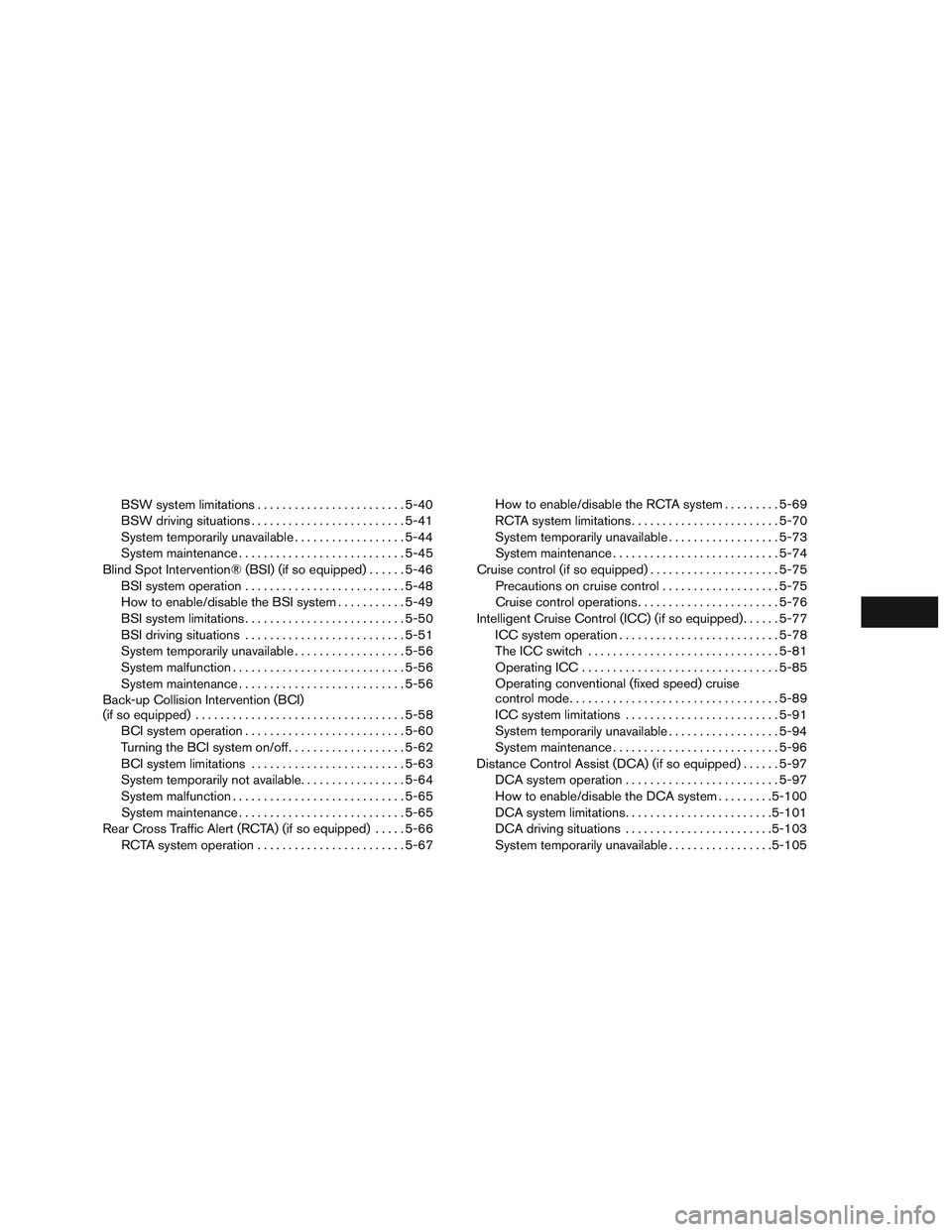
BSW system limitations........................ 5-40
BSW driving situations ......................... 5-41
System temporarily unavailable ..................5-44
System maintenance ........................... 5-45
Blind Spot Intervention® (BSI) (if so equipped) ......5-46
BSI system operation .......................... 5-48
How to enable/disable the BSI system ...........5-49
BSI system limitations .......................... 5-50
BSI driving situations .......................... 5-51
System temporarily unavailable ..................5-56
System malfunction ............................ 5-56
System maintenance ........................... 5-56
Back-up Collision Intervention (BCI)
(if so equipped) .................................. 5-58
BCI system operation .......................... 5-60
Turning the BCI system on/off ...................5-62
BCI system limitations ......................... 5-63
System temporarily not available .................5-64
System malfunction ............................ 5-65
System maintenance ........................... 5-65
Rear Cross Traffic Alert (RCTA) (if so equipped) .....5-66
RCTA system operation ........................ 5-67How to enable/disable the RCTA system .
........5-69
RCTA system limitations ........................ 5-70
System temporarily unavailable ..................5-73
System maintenance ........................... 5-74
Cruise control (if so equipped) .....................5-75
Precautions on cruise control . ..................5-75
Cruise control operations .......................5-76
Intelligent Cruise Control (ICC) (if so equipped) ......5-77
ICC system operation .......................... 5-78
The ICC switch ............................... 5-81
Operating ICC ................................ 5-85
Operating conventional (fixed speed) cruise
control mode .................................. 5-89
ICC system limitations ......................... 5-91
System
temporarily unavailable ..................5-94
System maintenance ........................... 5-96
Distance Control Assist (DCA) (if so equipped) ......5-97
DCA system operation ......................... 5-97
How to enable/disable the DCA system .........5-100
DCA system limitations ........................ 5-101
DCA driving situations ........................ 5-103
System temporarily unavailable .................5-105
Page 383 of 655
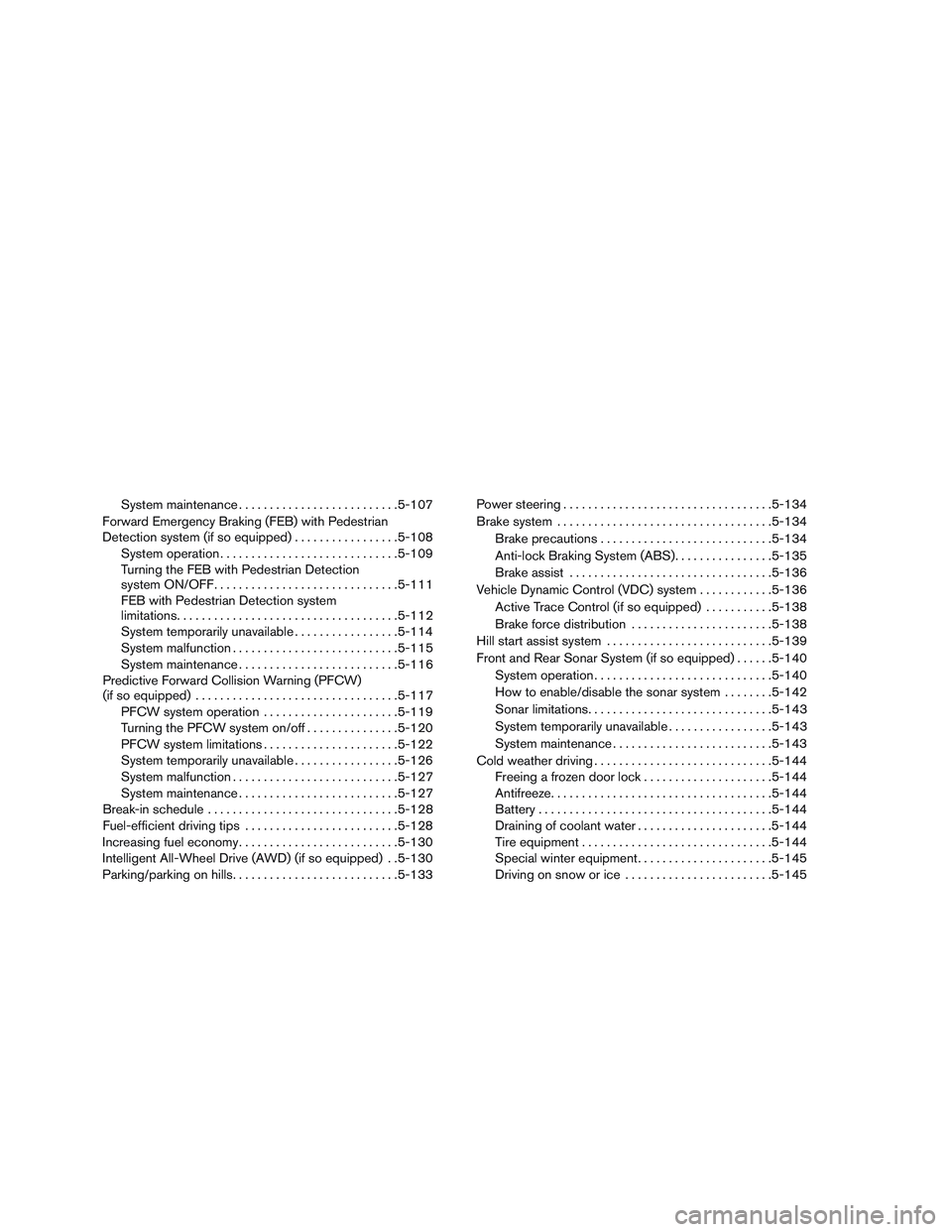
System maintenance.......................... 5-107
Forward Emergency Braking (FEB) with Pedestrian
Detection system (if so equipped) . . ...............5-108
System operation ............................. 5-109
Turning the FEB with Pedestrian Detection
system ON/OFF .............................. 5-111
FEB with Pedestrian Detection system
limitations .................................... 5-112
System temporarily unavailable .................5-114
System malfunction ........................... 5-115
System maintenance .......................... 5-116
Predictive Forward Collision Warning (PFCW)
(if so equipped) ................................. 5-117
PFCW system operation ......................5-119
Turning the PFCW system on/off ...............5-120
PFCW system limitations ......................5-122
System temporarily unavailable .................5-126
System malfunction ........................... 5-127
System maintenance .......................... 5-127
Break-in schedule ............................... 5-128
Fuel-efficient driving tips ......................... 5-128
Increasing fuel economy .......................... 5-130
Intelligent All-Wheel Drive (AWD) (if so equipped) . .5-130
Parking/parking on hills ........................... 5-133Power steering
.................................. 5-134
Brake system ................................... 5-134
Brake precautions ............................ 5-134
Anti-lock Braking System (ABS) ................5-135
Brake assist ................................. 5-136
Vehicle Dynamic Control (VDC) system ............5-136
Active Trace Control (if so equipped) ...........5-138
Brake force distribution ....................... 5-138
Hill start assist system ........................... 5-139
Front and Rear Sonar System (if so equipped) ......5-140
System operation ............................. 5-140
How to enable/disable the sonar system . .......5-142
Sonar limitations .............................. 5-143
System temporarily unavailable .................5-143
System
maintenance .......................... 5-143
Cold weather driving ............................. 5-144
Freeing a frozen door lock .....................5-144
Antifreeze .................................... 5-144
Battery ...................................... 5-144
Draining of coolant water ......................5-144
Tire equipment . . ............................. 5-144
Special winter equipment ......................5-145
Driving on snow or ice ........................ 5-145
Page 384 of 655
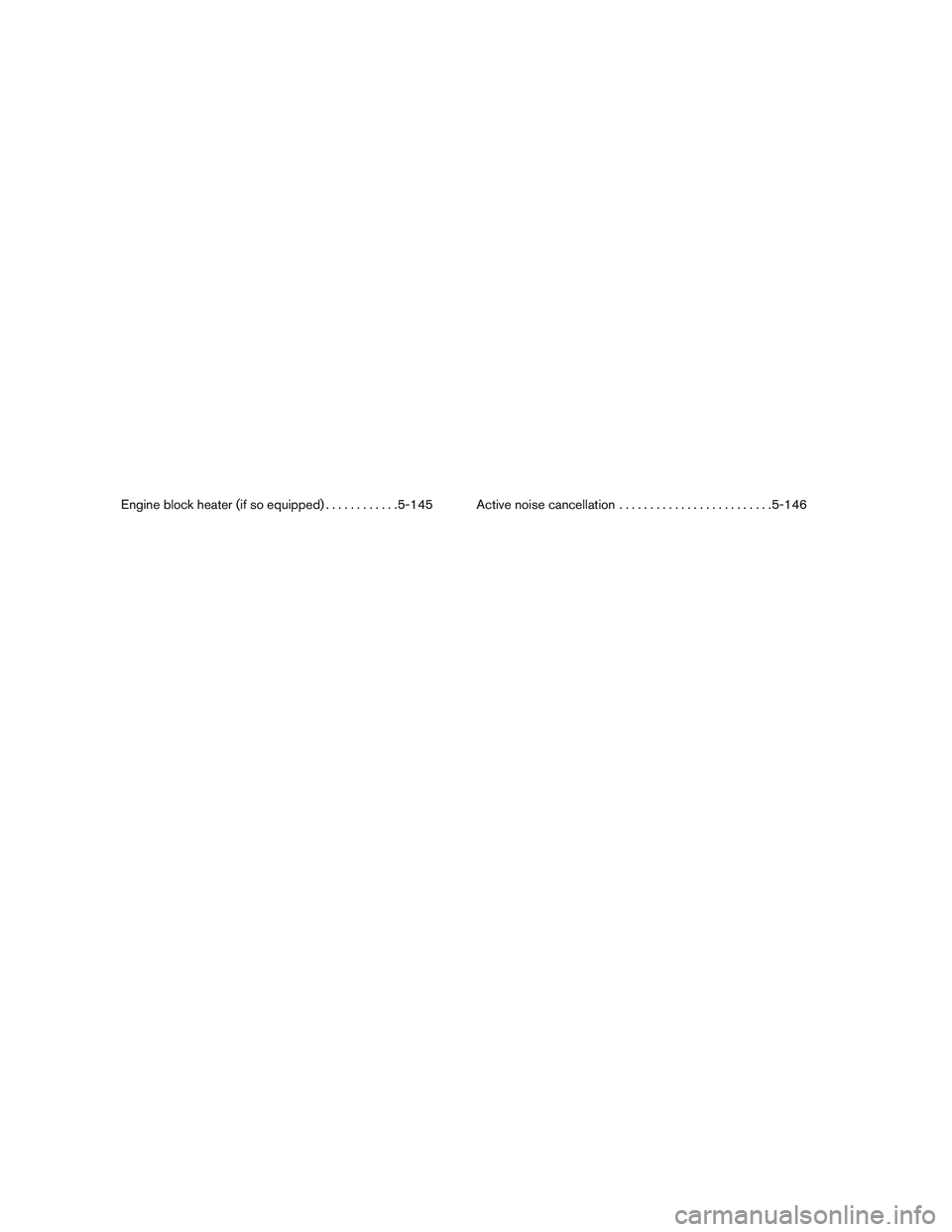
Engine block heater (if so equipped)............5-145 Active noise cancellation .........................5-146
Page 385 of 655
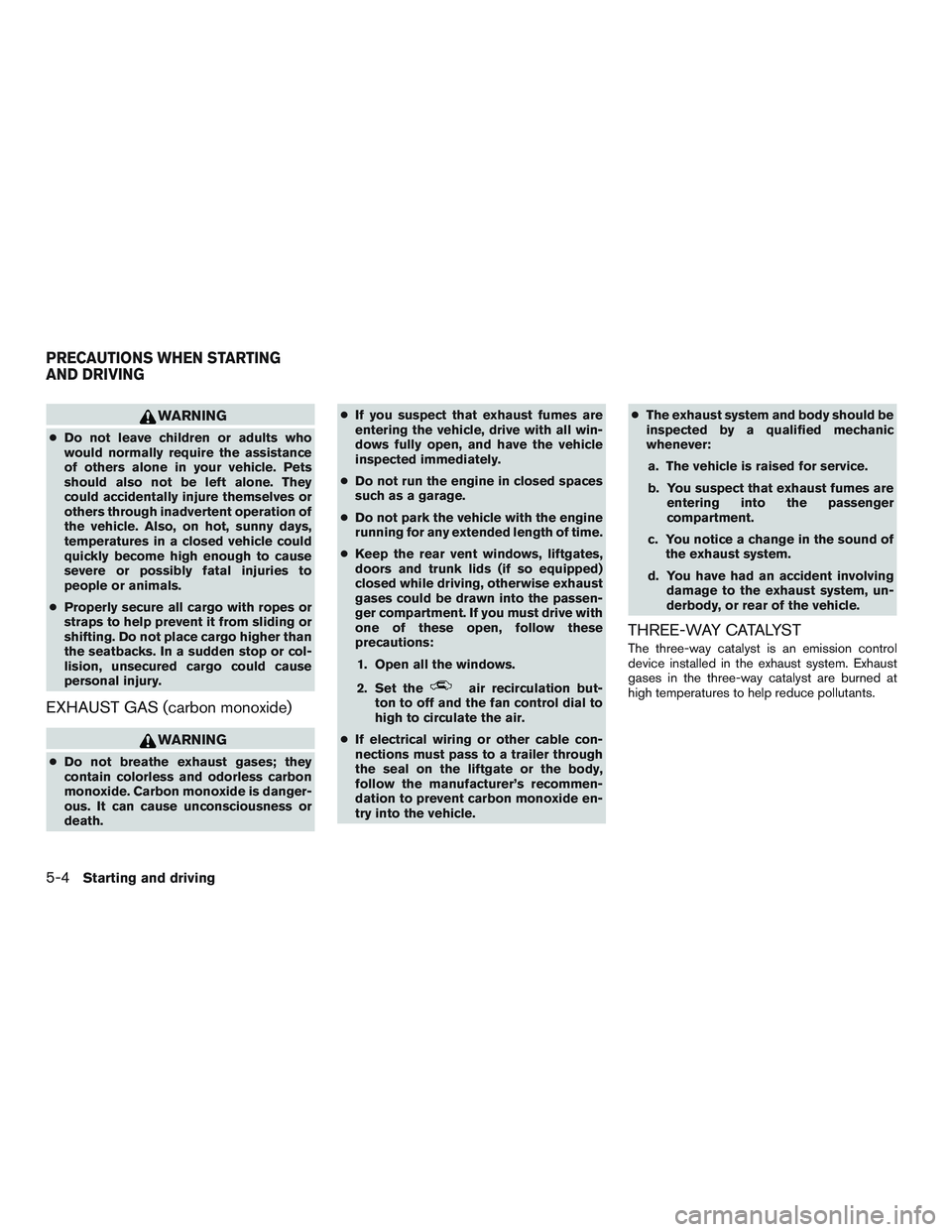
WARNING
●Do not leave children or adults who
would normally require the assistance
of others alone in your vehicle. Pets
should also not be left alone. They
could accidentally injure themselves or
others through inadvertent operation of
the vehicle. Also, on hot, sunny days,
temperatures in a closed vehicle could
quickly become high enough to cause
severe or possibly fatal injuries to
people or animals.
● Properly secure all cargo with ropes or
straps to help prevent it from sliding or
shifting. Do not place cargo higher than
the seatbacks. In a sudden stop or col-
lision, unsecured cargo could cause
personal injury.
EXHAUST GAS (carbon monoxide)
WARNING
● Do not breathe exhaust gases; they
contain colorless and odorless carbon
monoxide. Carbon monoxide is danger-
ous. It can cause unconsciousness or
death. ●
If you suspect that exhaust fumes are
entering the vehicle, drive with all win-
dows fully open, and have the vehicle
inspected immediately.
● Do not run the engine in closed spaces
such as a garage.
● Do not park the vehicle with the engine
running for any extended length of time.
● Keep the rear vent windows, liftgates,
doors and trunk lids (if so equipped)
closed while driving, otherwise exhaust
gases could be drawn into the passen-
ger compartment. If you must drive with
one of these open, follow these
precautions:
1. Open all the windows.
2. Set the
air recirculation but-
ton to off and the fan control dial to
high to circulate the air.
● If electrical wiring or other cable con-
nections must pass to a trailer through
the seal on the liftgate or the body,
follow the manufacturer’s recommen-
dation to prevent carbon monoxide en-
try into the vehicle. ●
The exhaust system and body should be
inspected by a qualified mechanic
whenever:
a. The vehicle is raised for service.
b. You suspect that exhaust fumes are entering into the passenger
compartment.
c. You notice a change in the sound of the exhaust system.
d. You have had an accident involving damage to the exhaust system, un-
derbody, or rear of the vehicle.
THREE-WAY CATALYST
The three-way catalyst is an emission control
device installed in the exhaust system. Exhaust
gases in the three-way catalyst are burned at
high temperatures to help reduce pollutants.
PRECAUTIONS WHEN STARTING
AND DRIVING
5-4Starting and driving
Page 386 of 655
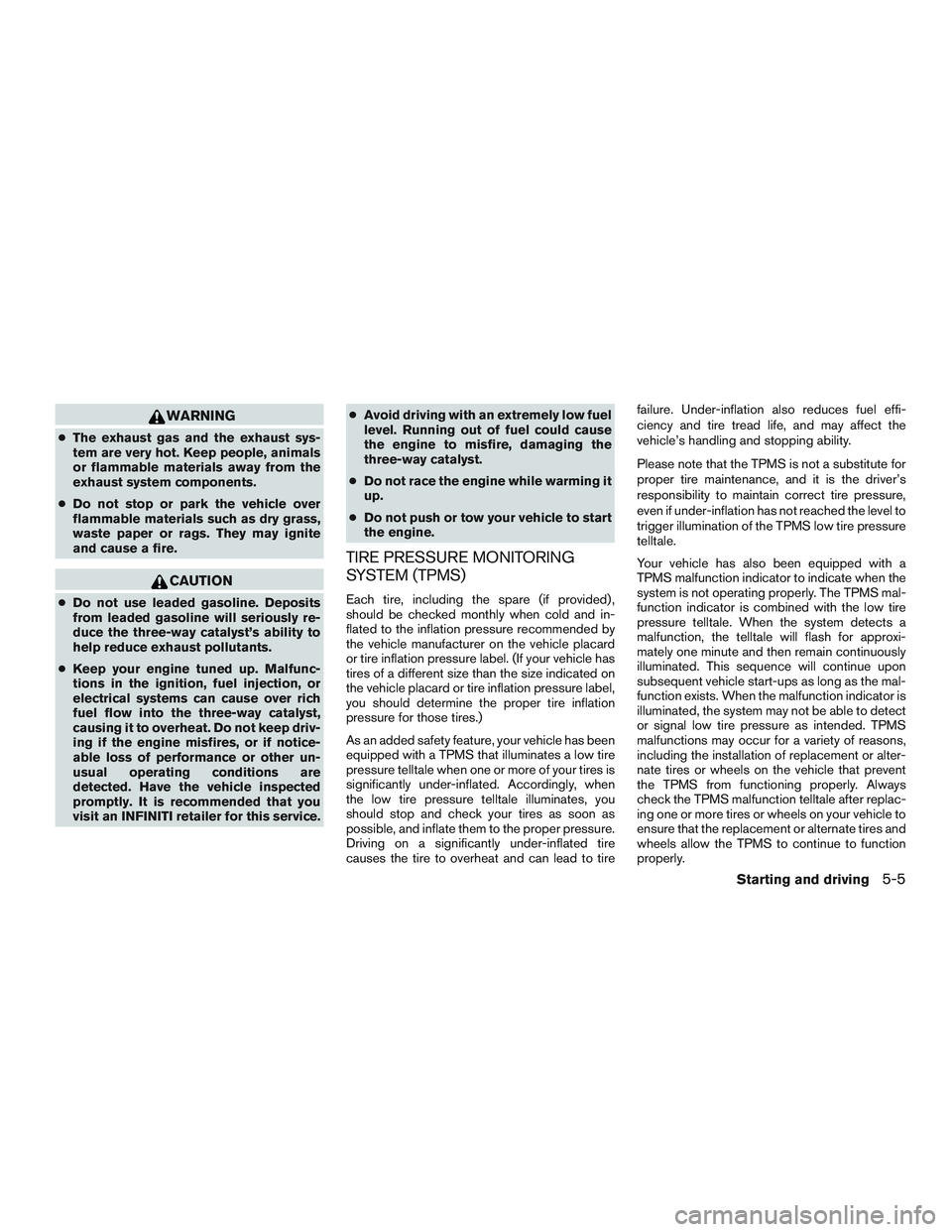
WARNING
●The exhaust gas and the exhaust sys-
tem are very hot. Keep people, animals
or flammable materials away from the
exhaust system components.
● Do not stop or park the vehicle over
flammable materials such as dry grass,
waste paper or rags. They may ignite
and cause a fire.
CAUTION
● Do not use leaded gasoline. Deposits
from leaded gasoline will seriously re-
duce the three-way catalyst’s ability to
help reduce exhaust pollutants.
● Keep your engine tuned up. Malfunc-
tions in the ignition, fuel injection, or
electrical systems can cause over rich
fuel flow into the three-way catalyst,
causing it to overheat. Do not keep driv-
ing if the engine misfires, or if notice-
able loss of performance or other un-
usual operating conditions are
detected. Have the vehicle inspected
promptly. It is recommended that you
visit an INFINITI retailer for this service. ●
Avoid driving with an extremely low fuel
level. Running out of fuel could cause
the engine to misfire, damaging the
three-way catalyst.
● Do not race the engine while warming it
up.
● Do not push or tow your vehicle to start
the engine.
TIRE PRESSURE MONITORING
SYSTEM (TPMS)
Each tire, including the spare (if provided) ,
should be checked monthly when cold and in-
flated to the inflation pressure recommended by
the vehicle manufacturer on the vehicle placard
or tire inflation pressure label. (If your vehicle has
tires of a different size than the size indicated on
the vehicle placard or tire inflation pressure label,
you should determine the proper tire inflation
pressure for those tires.)
As an added safety feature, your vehicle has been
equipped with a TPMS that illuminates a low tire
pressure telltale when one or more of your tires is
significantly under-inflated. Accordingly, when
the low tire pressure telltale illuminates, you
should stop and check your tires as soon as
possible, and inflate them to the proper pressure.
Driving on a significantly under-inflated tire
causes the tire to overheat and can lead to tire failure. Under-inflation also reduces fuel effi-
ciency and tire tread life, and may affect the
vehicle’s handling and stopping ability.
Please note that the TPMS is not a substitute for
proper tire maintenance, and it is the driver’s
responsibility to maintain correct tire pressure,
even if under-inflation has not reached the level to
trigger illumination of the TPMS low tire pressure
telltale.
Your vehicle has also been equipped with a
TPMS malfunction indicator to indicate when the
system is not operating properly. The TPMS mal-
function indicator is combined with the low tire
pressure telltale. When the system detects a
malfunction, the telltale will flash for approxi-
mately one minute and then remain continuously
illuminated. This sequence will continue upon
subsequent vehicle start-ups as long as the mal-
function exists. When the malfunction indicator is
illuminated, the system may not be able to detect
or signal low tire pressure as intended. TPMS
malfunctions may occur for a variety of reasons,
including the installation of replacement or alter-
nate tires or wheels on the vehicle that prevent
the TPMS from functioning properly. Always
check the TPMS malfunction telltale after replac-
ing one or more tires or wheels on your vehicle to
ensure that the replacement or alternate tires and
wheels allow the TPMS to continue to function
properly.
Starting and driving5-5
Page 387 of 655
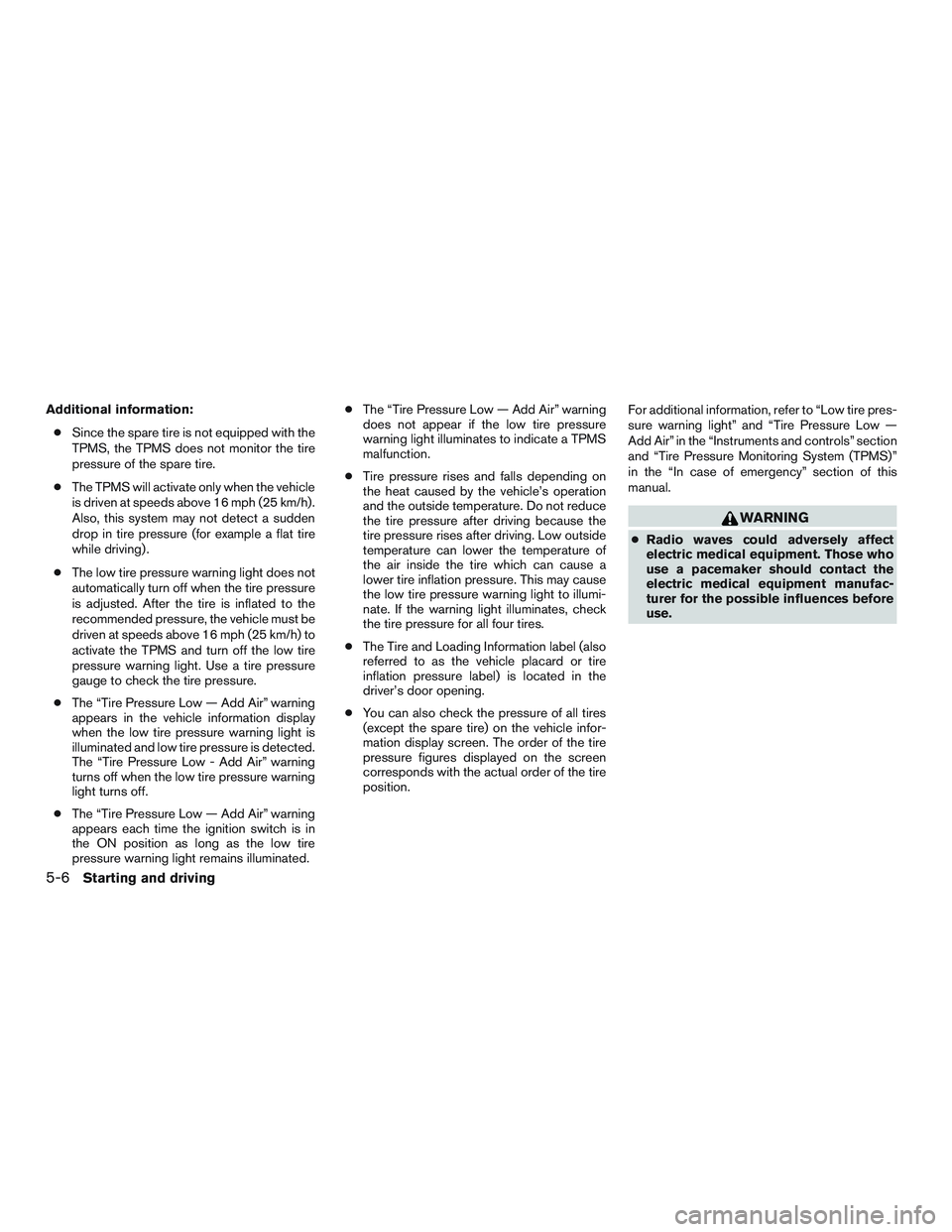
Additional information:● Since the spare tire is not equipped with the
TPMS, the TPMS does not monitor the tire
pressure of the spare tire.
● The TPMS will activate only when the vehicle
is driven at speeds above 16 mph (25 km/h).
Also, this system may not detect a sudden
drop in tire pressure (for example a flat tire
while driving) .
● The low tire pressure warning light does not
automatically turn off when the tire pressure
is adjusted. After the tire is inflated to the
recommended pressure, the vehicle must be
driven at speeds above 16 mph (25 km/h) to
activate the TPMS and turn off the low tire
pressure warning light. Use a tire pressure
gauge to check the tire pressure.
● The “Tire Pressure Low — Add Air” warning
appears in the vehicle information display
when the low tire pressure warning light is
illuminated and low tire pressure is detected.
The “Tire Pressure Low - Add Air” warning
turns off when the low tire pressure warning
light turns off.
● The “Tire Pressure Low — Add Air” warning
appears each time the ignition switch is in
the ON position as long as the low tire
pressure warning light remains illuminated. ●
The “Tire Pressure Low — Add Air” warning
does not appear if the low tire pressure
warning light illuminates to indicate a TPMS
malfunction.
● Tire pressure rises and falls depending on
the heat caused by the vehicle’s operation
and the outside temperature. Do not reduce
the tire pressure after driving because the
tire pressure rises after driving. Low outside
temperature can lower the temperature of
the air inside the tire which can cause a
lower tire inflation pressure. This may cause
the low tire pressure warning light to illumi-
nate. If the warning light illuminates, check
the tire pressure for all four tires.
● The Tire and Loading Information label (also
referred to as the vehicle placard or tire
inflation pressure label) is located in the
driver’s door opening.
● You can also check the pressure of all tires
(except the spare tire) on the vehicle infor-
mation display screen. The order of the tire
pressure figures displayed on the screen
corresponds with the actual order of the tire
position. For additional information, refer to “Low tire pres-
sure warning light” and “Tire Pressure Low —
Add Air” in the “Instruments and controls” section
and “Tire Pressure Monitoring System (TPMS)”
in the “In case of emergency” section of this
manual.
WARNING
●
Radio waves could adversely affect
electric medical equipment. Those who
use a pacemaker should contact the
electric medical equipment manufac-
turer for the possible influences before
use.
5-6Starting and driving
Page 388 of 655
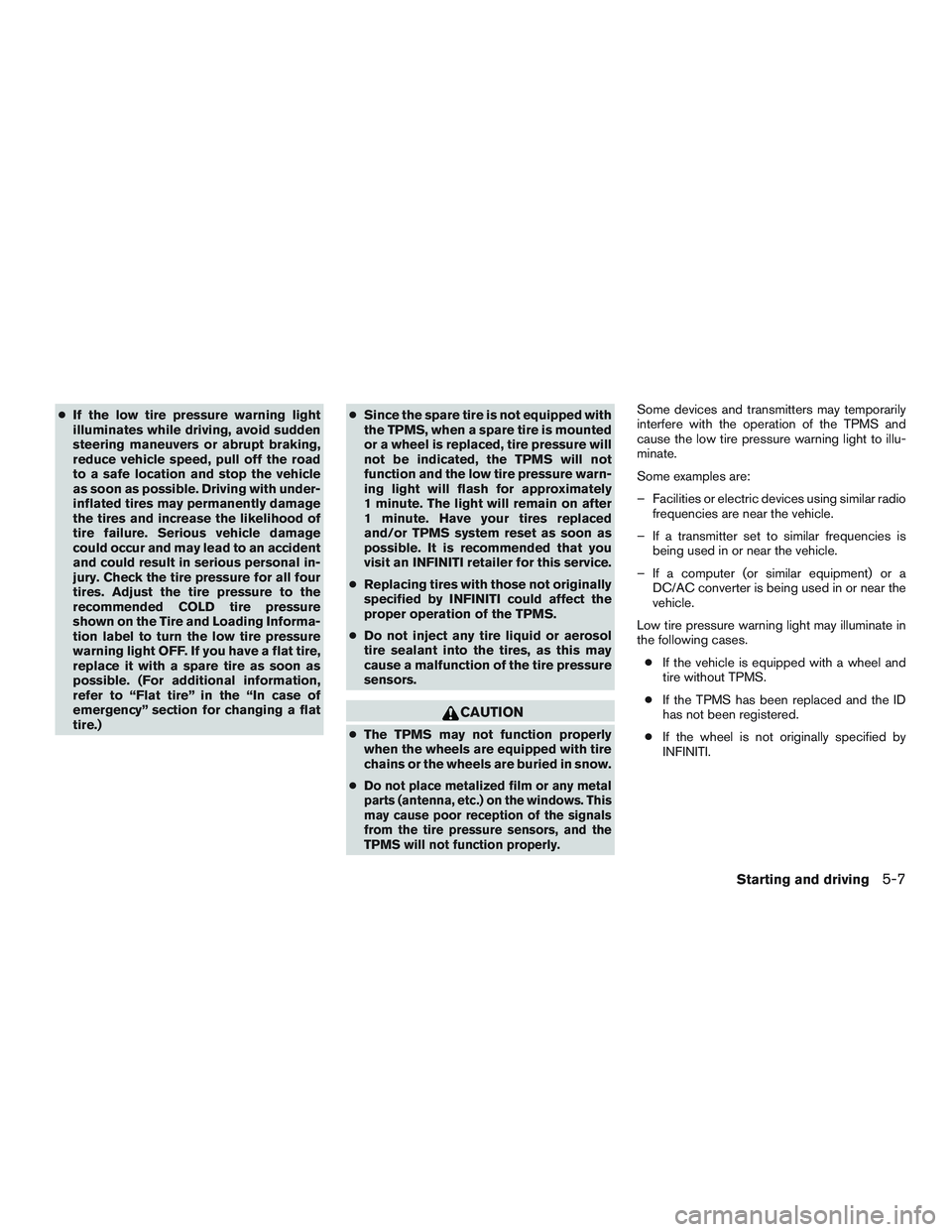
●If the low tire pressure warning light
illuminates while driving, avoid sudden
steering maneuvers or abrupt braking,
reduce vehicle speed, pull off the road
to a safe location and stop the vehicle
as soon as possible. Driving with under-
inflated tires may permanently damage
the tires and increase the likelihood of
tire failure. Serious vehicle damage
could occur and may lead to an accident
and could result in serious personal in-
jury. Check the tire pressure for all four
tires. Adjust the tire pressure to the
recommended COLD tire pressure
shown on the Tire and Loading Informa-
tion label to turn the low tire pressure
warning light OFF. If you have a flat tire,
replace it with a spare tire as soon as
possible. (For additional information,
refer to “Flat tire” in the “In case of
emergency” section for changing a flat
tire.) ●
Since the spare tire is not equipped with
the TPMS, when a spare tire is mounted
or a wheel is replaced, tire pressure will
not be indicated, the TPMS will not
function and the low tire pressure warn-
ing light will flash for approximately
1 minute. The light will remain on after
1 minute. Have your tires replaced
and/or TPMS system reset as soon as
possible. It is recommended that you
visit an INFINITI retailer for this service.
● Replacing tires with those not originally
specified by INFINITI could affect the
proper operation of the TPMS.
● Do not inject any tire liquid or aerosol
tire sealant into the tires, as this may
cause a malfunction of the tire pressure
sensors.
CAUTION
● The TPMS may not function properly
when the wheels are equipped with tire
chains or the wheels are buried in snow.
●
Do not place metalized film or any metal
parts (antenna, etc.) on the windows. This
may cause poor reception of the signals
from the tire pressure sensors, and the
TPMS will not function properly.
Some devices and transmitters may temporarily
interfere with the operation of the TPMS and
cause the low tire pressure warning light to illu-
minate.
Some examples are:
– Facilities or electric devices using similar radio frequencies are near the vehicle.
– If a transmitter set to similar frequencies is being used in or near the vehicle.
– If a computer (or similar equipment) or a DC/AC converter is being used in or near the
vehicle.
Low tire pressure warning light may illuminate in
the following cases. ● If the vehicle is equipped with a wheel and
tire without TPMS.
● If the TPMS has been replaced and the ID
has not been registered.
● If the wheel is not originally specified by
INFINITI.
Starting and driving5-7
Page 389 of 655
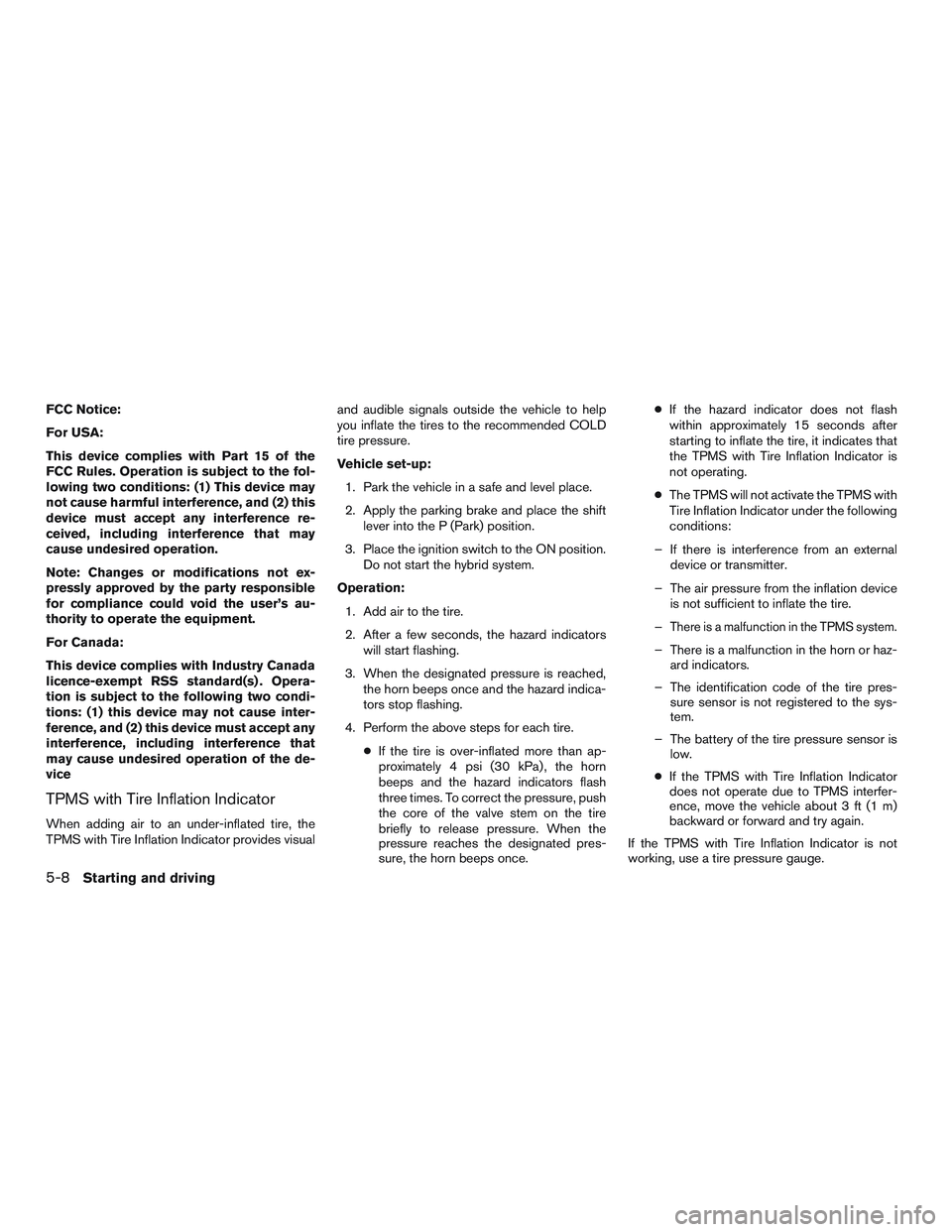
FCC Notice:
For USA:
This device complies with Part 15 of the
FCC Rules. Operation is subject to the fol-
lowing two conditions: (1) This device may
not cause harmful interference, and (2) this
device must accept any interference re-
ceived, including interference that may
cause undesired operation.
Note: Changes or modifications not ex-
pressly approved by the party responsible
for compliance could void the user’s au-
thority to operate the equipment.
For Canada:
This device complies with Industry Canada
licence-exempt RSS standard(s) . Opera-
tion is subject to the following two condi-
tions: (1) this device may not cause inter-
ference, and (2) this device must accept any
interference, including interference that
may cause undesired operation of the de-
vice
TPMS with Tire Inflation Indicator
When adding air to an under-inflated tire, the
TPMS with Tire Inflation Indicator provides visualand audible signals outside the vehicle to help
you inflate the tires to the recommended COLD
tire pressure.
Vehicle set-up:
1. Park the vehicle in a safe and level place.
2. Apply the parking brake and place the shift lever into the P (Park) position.
3. Place the ignition switch to the ON position. Do not start the hybrid system.
Operation: 1. Add air to the tire.
2. After a few seconds, the hazard indicators will start flashing.
3. When the designated pressure is reached, the horn beeps once and the hazard indica-
tors stop flashing.
4. Perform the above steps for each tire. ●If the tire is over-inflated more than ap-
proximately 4 psi (30 kPa) , the horn
beeps and the hazard indicators flash
three times. To correct the pressure, push
the core of the valve stem on the tire
briefly to release pressure. When the
pressure reaches the designated pres-
sure, the horn beeps once. ●
If the hazard indicator does not flash
within approximately 15 seconds after
starting to inflate the tire, it indicates that
the TPMS with Tire Inflation Indicator is
not operating.
● The TPMS will not activate the TPMS with
Tire Inflation Indicator under the following
conditions:
– If there is interference from an external device or transmitter.
– The air pressure from the inflation device is not sufficient to inflate the tire.
–
There is a malfunction in the TPMS system.
– There is a malfunction in the horn or haz- ard indicators.
– The identification code of the tire pres- sure sensor is not registered to the sys-
tem.
– The battery of the tire pressure sensor is low.
● If the TPMS with Tire Inflation Indicator
does not operate due to TPMS interfer-
ence, move the vehicle about 3 ft (1 m)
backward or forward and try again.
If the TPMS with Tire Inflation Indicator is not
working, use a tire pressure gauge.
5-8Starting and driving
Page 390 of 655
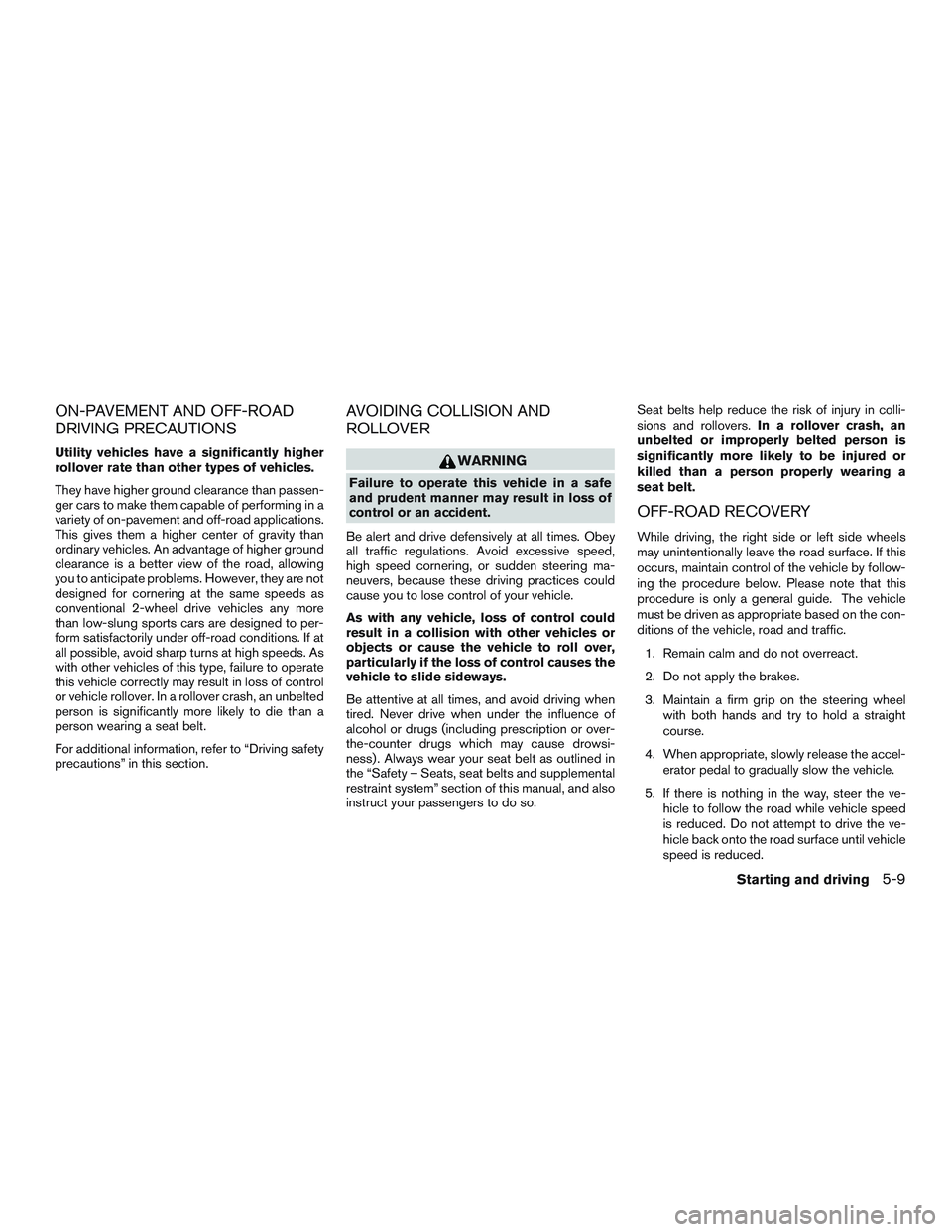
ON-PAVEMENT AND OFF-ROAD
DRIVING PRECAUTIONS
Utility vehicles have a significantly higher
rollover rate than other types of vehicles.
They have higher ground clearance than passen-
ger cars to make them capable of performing in a
variety of on-pavement and off-road applications.
This gives them a higher center of gravity than
ordinary vehicles. An advantage of higher ground
clearance is a better view of the road, allowing
you to anticipate problems. However, they are not
designed for cornering at the same speeds as
conventional 2-wheel drive vehicles any more
than low-slung sports cars are designed to per-
form satisfactorily under off-road conditions. If at
all possible, avoid sharp turns at high speeds. As
with other vehicles of this type, failure to operate
this vehicle correctly may result in loss of control
or vehicle rollover. In a rollover crash, an unbelted
person is significantly more likely to die than a
person wearing a seat belt.
For additional information, refer to “Driving safety
precautions” in this section.
AVOIDING COLLISION AND
ROLLOVER
WARNING
Failure to operate this vehicle in a safe
and prudent manner may result in loss of
control or an accident.
Be alert and drive defensively at all times. Obey
all traffic regulations. Avoid excessive speed,
high speed cornering, or sudden steering ma-
neuvers, because these driving practices could
cause you to lose control of your vehicle.
As with any vehicle, loss of control could
result in a collision with other vehicles or
objects or cause the vehicle to roll over,
particularly if the loss of control causes the
vehicle to slide sideways.
Be attentive at all times, and avoid driving when
tired. Never drive when under the influence of
alcohol or drugs (including prescription or over-
the-counter drugs which may cause drowsi-
ness) . Always wear your seat belt as outlined in
the “Safety – Seats, seat belts and supplemental
restraint system” section of this manual, and also
instruct your passengers to do so. Seat belts help reduce the risk of injury in colli-
sions and rollovers.
In a rollover crash, an
unbelted or improperly belted person is
significantly more likely to be injured or
killed than a person properly wearing a
seat belt.
OFF-ROAD RECOVERY
While driving, the right side or left side wheels
may unintentionally leave the road surface. If this
occurs, maintain control of the vehicle by follow-
ing the procedure below. Please note that this
procedure is only a general guide. The vehicle
must be driven as appropriate based on the con-
ditions of the vehicle, road and traffic.
1. Remain calm and do not overreact.
2. Do not apply the brakes.
3. Maintain a firm grip on the steering wheel with both hands and try to hold a straight
course.
4. When appropriate, slowly release the accel- erator pedal to gradually slow the vehicle.
5. If there is nothing in the way, steer the ve- hicle to follow the road while vehicle speed
is reduced. Do not attempt to drive the ve-
hicle back onto the road surface until vehicle
speed is reduced.
Starting and driving5-9